John Sanborn porta il suo lavoro nelle sale di MEET con la mostra Out Of Order, la sua prima personale in Italia, visitabile fino a domenica 8 settembre 2024. Il sentimento della trasformazione anima l’opera dell’eclettico artista membro chiave della seconda ondata di videoartisti americani che include Bill Viola, Gary Hill, Dara Birnbaum e Tony Oursler,
Dopo un tour che ha toccato diverse città della penisola, John Sanborn è tornato a Milano come protagonista di un illuminante incontro del format Meet the Media Guru. In quell’occasione ho avuto modo di dialogare a lungo con lui e ho così conosciuto meglio la sua storia umana e artistica connotata dall’instancabile sperimentazione, appreso dalla sua viva voce come ami unire sempre diversi linguaggi espressivi al gioco della tecnologia, e di come consideri importante la collaborazione con altri artisti (e con la loro storia) per portare alla luce nuove prospettive esistenziali sul presente e sul futuro.
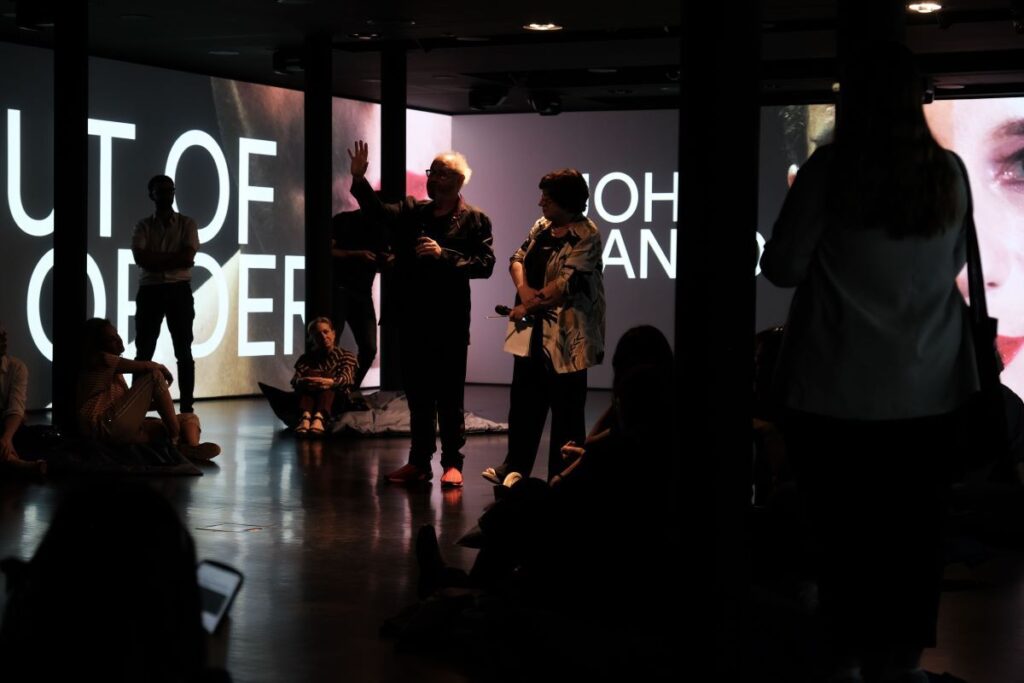
Si sente lo spirito del tempo nella videoarte di John Sanborn, della trasformazione interiore e sociale, con l’invito ad accogliere questo dinamismo dell’identità, della relazione e della comunicazione, anche attraverso memoria e mitologie.
Prima di addentrarmi nel suo mondo mi sembra utile dare alcune informazioni sull’imperdibile mostra. Il percorso espositivo di Out of Order, progettato da Migliore+Servetto, è inteso come un viaggio nel tempo dagli esordi della carriera dell’artista americano, partendo dalle videoinstallazioni degli anni ’70, passando dal periodo d’oro della scena video-musicale di MTV e dell’arte interattiva, fino ai nuovi lavori di digital media art, di cui John Sanborn può chiamarsi pioniere.
Anche nella scelta del titolo, trovato in collaborazione con Maria Grazia Mattei, fondatrice e presidente di MEET, Out of Order esprime il sentimento della trasformazione come ragione d’arte e di vita. Fuori dall’ordinario, in modo inaspettato, l’opera intende farvi cambiare punto di vista su un’idea, un personaggio, un’emozione, portando chi la vive a ”guardare al mondo proprio come facciamo noi artisti, fuori servizio”.
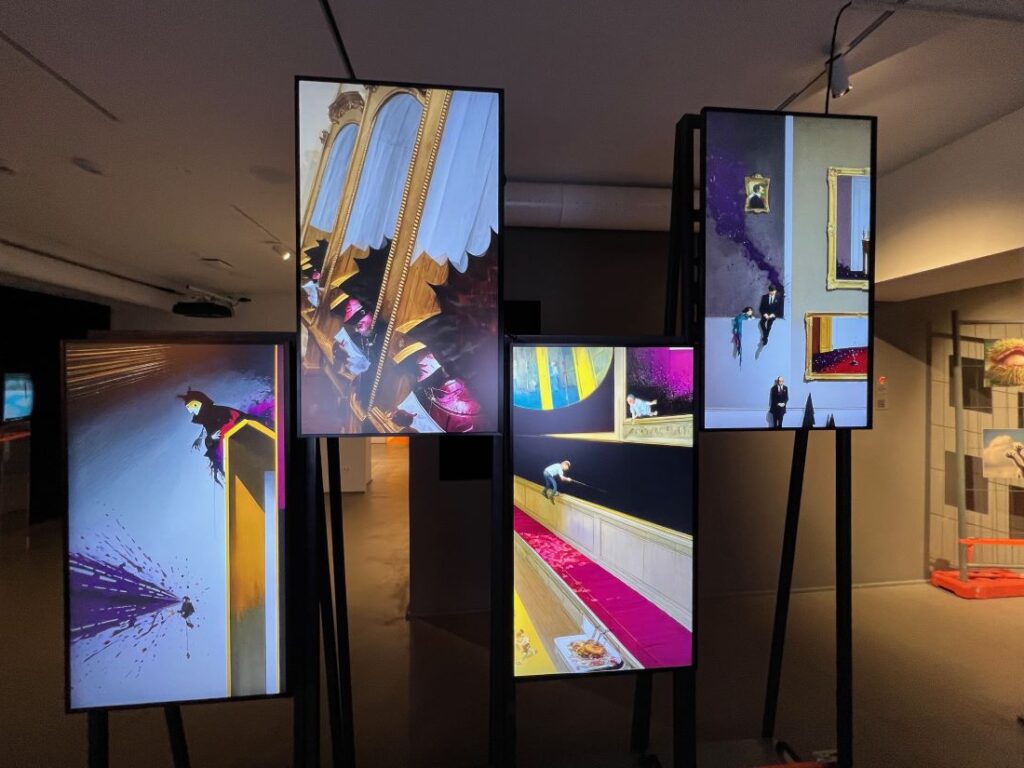
Nella prima gallery osserviamo lavori degli anni ‘70, ‘80 e ‘90. Sono tutti in analogico, visibili all’interno di monitor a tubo catodico. Interessante l’allestimento secondo la logica del collage e dell’installazione unica che va letta come un flusso di “come le mie ossessioni siano diventate sempre più complesse”. Un principio che attiva nello spettatore proprio quel sentimento della trasformazione, donando un fil rouge narrativo più coinvolgente al gruppo di lavori storici, come aveva già fatto per la grande retrospettiva Between Order and Entropy presso ZKM Karlsruhe.
Dici che le opere di quegli anni sono state seminali. Cosa pensi che viva ancora di quel periodo nella tua ricerca?
Il mio amico Dr. Peter Weibel, una persona molto brillante, che era CEO di ZKM, mi disse che avere un piede nel passato e uno nel futuro è il posto migliore in cui stare. Il tempo è passato, la tecnologia è cambiata, il mondo è diverso, ma molto di ciò che mi ossessionava durante i miei primi anni ispira ancora la mia passione e la mia creatività. Voglio alterare il tempo e lo spazio per rappresentare il mondo come lo vedo io. Mi spinge a definire e trasformare. Mi piace trovare domande a cui non possiamo rispondere, sollevarle. E soprattutto mi piace la capacità di indagare: chi siamo, come siamo arrivati qui e dove stiamo andando.
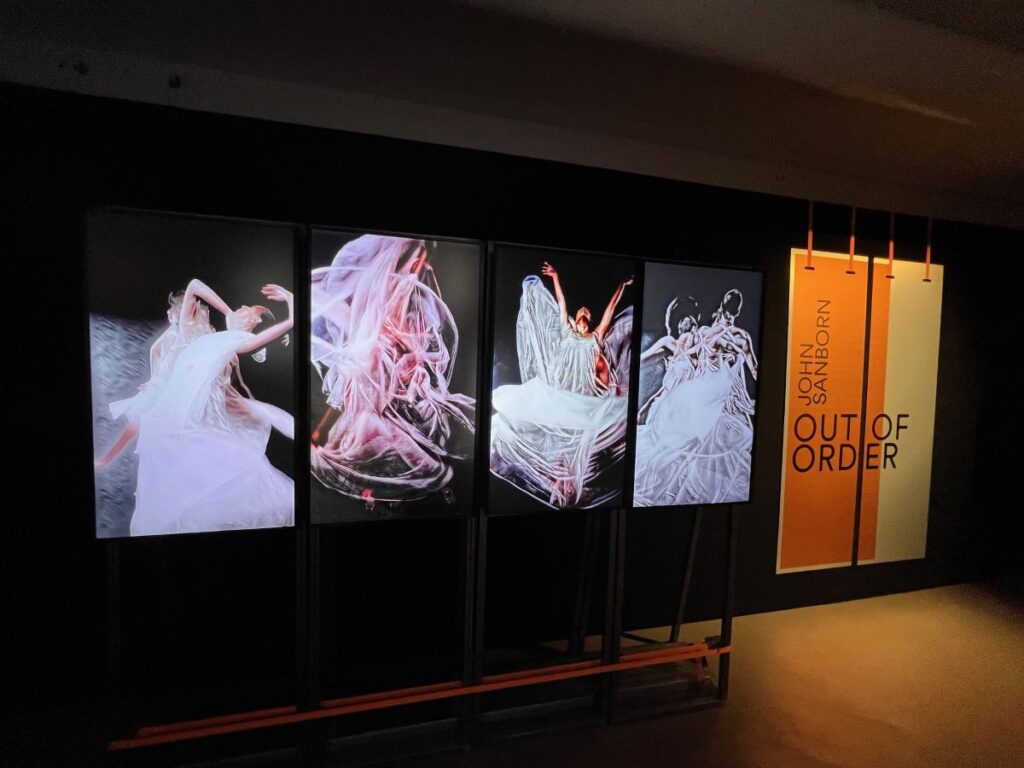
Nella seconda gallery notiamo le opere: Body Quartets e Mind Quartets, installazioni video concepite per raccontare uno stato di trasformazione del nostro Io. Out of Chaos | Frisson è invece una sequenza AI/AR di 60 istanti di storie esplorate con la realtà aumentata utilizzando l’app EyeJack, realizzata in collaborazione con l’artista Lali Wilde.
Nel contesto in cui corpo e mente parlano di comunicazione, qual è il valore, la funzione estetica della danza all’interno delle tue storie?
La danza è una prova di vita, poiché il corpo esprime il desiderio, il coraggio, la salute, l’età, tanti aspetti dell’esistenza in modi che superano il linguaggio verbale e l’immagine. Uso la danza per dire cose che le parole non riescono a esprimere e per creare forme di umanità che posso usare per colmare le lacune tra espressione e comprensione. I nostri corpi sono volontà, personificati attraverso una fisicità che non può essere ignorata o negata.

Com’è cambiato il tuo rapporto con la tecnologia nel corso degli anni?
Il mio rapporto con la tecnologia non è cambiato affatto. Sono ancora stimolato dagli strumenti e dal modo in cui possono facilitare la mia pratica. Ogni nuovo progresso mi ha permesso di fare qualcosa di diverso o di più completo, offrendomi più possibilità con cui creare. All’inizio era la pura indipendenza della registrazione, poi la precisione dell’editing accurato dei fotogrammi, quindi la stratificazione e il riposizionamento. Un grande salto è stato quello dall’analogico al video digitale “da tavolo”, che mi ha dato la libertà di espandere il mio campo d’azione e di ampliare la scala del mio lavoro. I recenti strumenti generativi sono ancora in fase di sviluppo ed è un piacere “ballare” di nuovo con la macchina.

La terza gallery offre Mythic Status. Una composizione di quattro video, ciascuno con una narrazione a sé, come ritratti delle divinità classiche Apollo, Atalanta, Nyx ed Ercole, incarnati da altrettanti performer queer e gender fluid, mescolando la propria personalità al personaggio mitologico. Anche l’opera monumentale V+M cambia il punto di vista su una storia antica, partendo da un tema classico come il desiderio, intriso di elementi contemporanei. Venus+Mars ricostruisce sulle tre pareti della sala immersiva l’installazione a 9 canali del 2016, realizzata per il Festival VideoFormes fondato e diretto da Gabriel Soucheyre, acquisita da Kunsthalle Praga nel 2022.
Perché in lavori come V+M e in Mythic Status hai coinvolto La mitologia e la pittura del passato, includendo nuove visioni contemporanee come quella LGBTQ+?
Per V+M, poiché mi interessava “la storia della storia di”, ho pensato di smontare la storia di Venere e Marte per capire meglio come siamo arrivati alla rappresentazione di uomini e donne che è stata accettata, e ripetuta, per centinaia di anni. Perché leghiamo entrambe le divinità al ruolo di genere? Marte deve essere per forza un uomo e Venere una donna? E se sì, perché?

In varie versioni la relazione amorosa tra Venere e Marte equivale al peccato, e all’intimità raggiunta viene assegnato un modello specifico: i diversi generi partecipano a un rituale. Questo equivoco (in realtà una falla nella narrazione) è facilmente eliminabile quando si passano in rassegna tutte le sfumature di Venere come nuda supplicante e di Marte come suo amante ribelle. Le immagini dipinte sono spesso invertite, quindi è facile per me riscrivere la loro storia. Le “prove” mi permettono di condannare le nostre convinzioni e di dire con orgoglio che siamo tutti V+M.
Abbiamo bisogno di una nuova mitologia, per raccontare quel racconto del racconto?
Con Mythic Status credo che abbiamo effettivamente iniziato a scrivere le nostre mitologie di genere, poiché il profilo degli dei rispetto agli esseri umani è sempre stato quello di creare un desiderato “stato alterato”, per contrastare una gloria immaginata, rispetto alla vita umana di tutti i giorni. Se le persone coraggiose mettono da parte gli “dei” per creare una libertà per se stesse, allora non ha senso celebrarle e offrire le loro storie al posto di semplicistici racconti morali? Mi è sembrato molto meglio riconoscere gli individui eroici, piuttosto che elevare meta-umani fittizi, e dedicare il nostro tempo a raccontarli e ri-raccontarli.
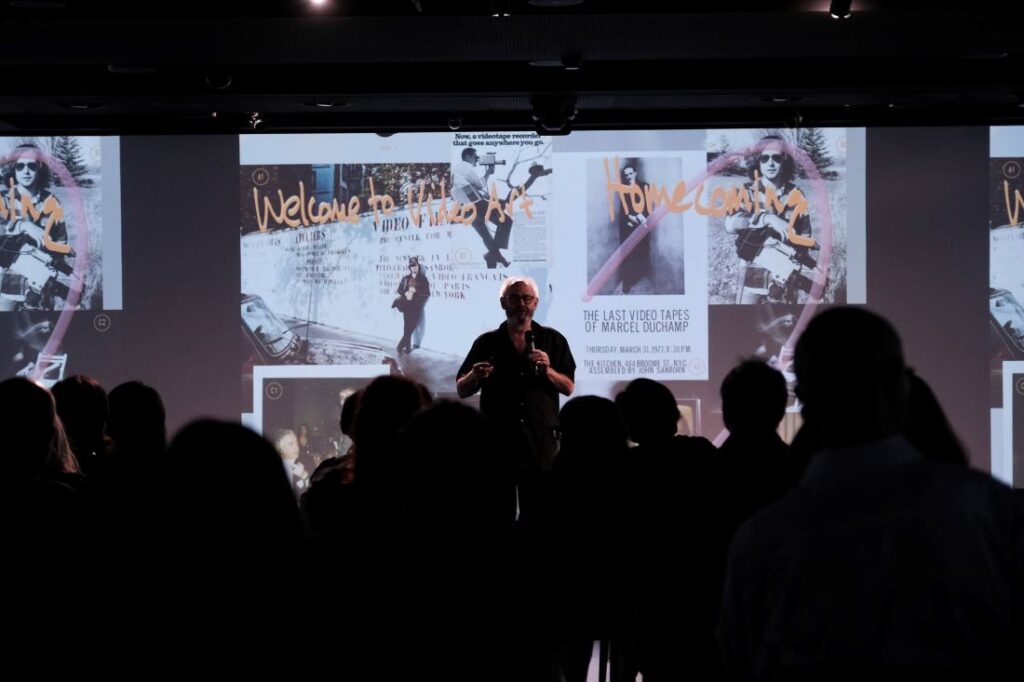
Dici che così tanto di quello che hai fatto è connesso ad altre persone, che immergersi e farsi contaminare dal lavoro di altri è una prerogativa irrinunciabile nel tuo modus operandi. Ci puoi parlare di almeno due collaborazioni per te preziose?
Ottima domanda. Certamente ho lavorato con molti grandi artisti, e Nam June Paik e Robert Ashley hanno avuto un enorme impatto sulla mia vita e sul mio lavoro. Per quanto riguarda i casi specifici in cui una collaborazione ha modificato la mia vita e il mio lavoro, ne ricordo molti, ma eccone due.
Nel creare Untitled (1989), con Bill T. Jones, mi sono confrontato con comunità (queer e persone di colore) e valori che andavano oltre la mia zona di comfort, per cui ho dovuto ascoltare, rispondere e riconoscere atteggiamenti che non avevo mai accolto prima. Stavo dando forma a un’espressione molto intima del dolore che parlava direttamente, in prima persona, di morte, AIDS e perdita di un compagno di vita e di lavoro. Si trattava di temi enormi che hanno messo a dura prova la mia capacità di rendere il sentimento della trasformazione collegando, movimento, testo e il video, per abbracciare argomenti che avremmo preferito evitare. Comunicare queste emozioni così forti a un pubblico significava che dovevo trovare in me stesso punti specifici di empatia, per poter incanalare veramente la rabbia e il dolore di Bill.
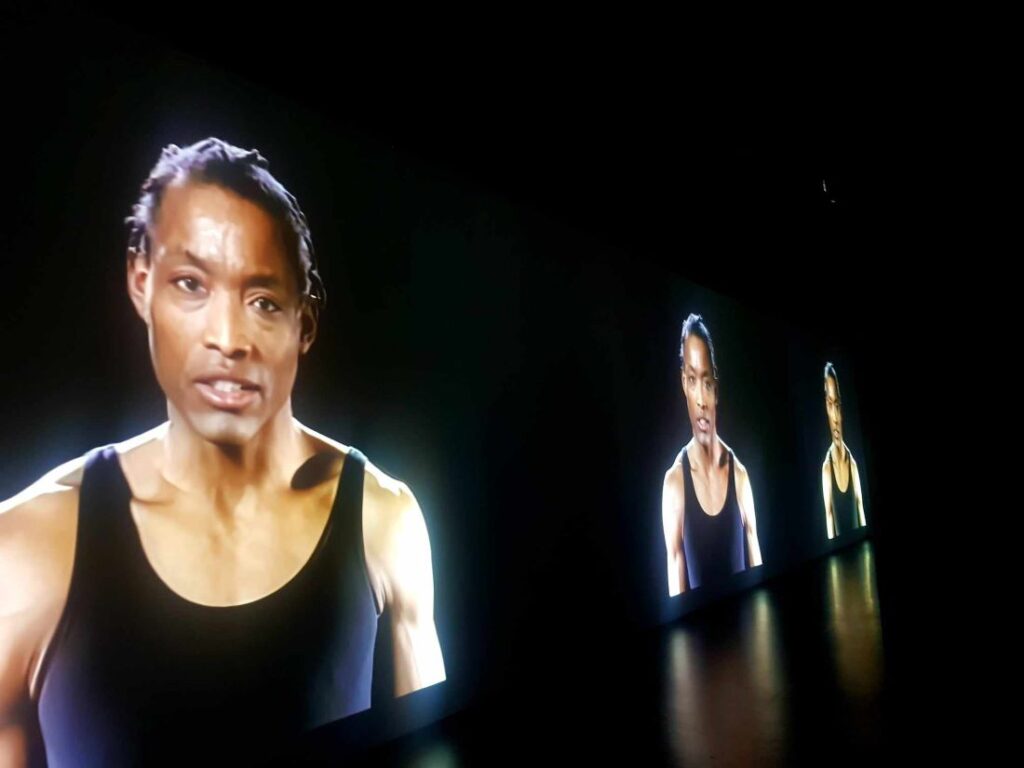
Quando mi è venuta l’idea di creare Mythic Status e mi è stata presentata Jiz Lee, mi sono trovato completamente spaesato e ben oltre la comprensione della fluidità di genere, ma desideroso di ascoltare e capire.
Jiz è una pornostar gender queer, autrice, attivista e icona di trasformazione. (Anche agli altri performer gender fluid e trans- come Ramsey Rodstein/Ercole) ho spiegato cosa volevo ottenere, il che deve essere sembrato folle, ma loro mi hanno raccontato la loro storia, le loro scelte e il modo in cui hanno ristrutturato la loro vita per poter essere “se stessi”. Abbiamo parlato di pronomi, di scelte di genere (il genere NON è il sesso) e della complessità di chiedere al mondo di rispettare scelte che potrebbero non comprendere. Tutto ciò è confluito nel lavoro, poiché ho usato il mio risveglio come modello per ciò che speravo accadesse con gli spettatori.
In una recente presentazione Sanborn dichiara che per “opere più grandi, opere installate, stiamo parlando di una combinazione di tempo e spazio, e dell’uso del corpo per sperimentare effettivamente l’opera”.
Puoi spiegarmi come tutto ciò avviene nel remaking dell’opera V+M nella sala immersiva del MEET?
In tutte le versioni di V+M (3 in realtà) chiedo allo spettatore di NON stare lì a guardare le belle immagini, e rendo impossibile farlo per apprezzare veramente il lavoro. È troppo grande per essere scansionata in una sola volta, quindi bisogna muovere il corpo, girare la testa e (metaforicamente) permettere all’opera di muoversi. Pur non rifiutando l’apprezzamento passivo dell’arte, la mente vuole esplorare e porre domande quando vede qualcosa di creativo. Perché non chiedere anche al corpo di partecipare a questa esperienza?
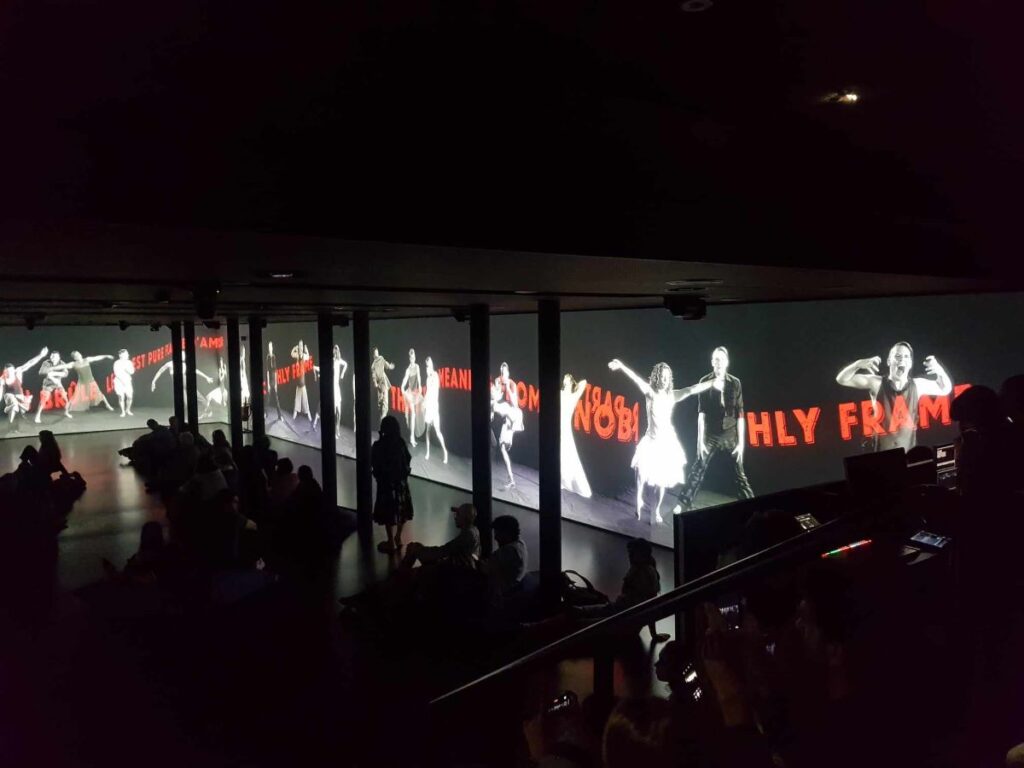
Ho progettato la struttura di V+M per istigare il movimento su larga scala a raccontare “la storia della storia di” Venere e Marte, fondendo l’ampiezza di questa epica storia d’amore con immagini coreografate e ondate di musica che insistono sul coinvolgimento del corpo e della mente. E sì, voglio che tutti ballino il tango!
Lo slancio verso la trasformazione, preziosa parola chiave per comprendere tutta la produzione di John Sanborn, invita a mettere in discussione percezioni e pregiudizi. Come abbiamo appreso spesso i performer coinvolti incarnano con la loro vita e la loro azione in scena, grandi questioni come l’identità, (anche di genere e legata alla disabilità), la giustizia sociale, l’inclusione. Così partecipiamo attivamente al funzionamento di opere nate per attivare interrogativi attraverso scenari disobbedienti ad una tradizione narrativa. «Non sempre per risolvere i nostri problemi, ma per affrontare la nostra condizione, comprenderla e chiedere di fare qualcosa per cambiare, a partire da noi stessi», vivendo il mondo OUT OF ORDER. Un messaggio profondo esplorato nel mese del Pride, nel quartiere milanese di Porta di Venezia “abitato” dalla comunità LGBTQ+, dove ha sede MEET che con essa condivide il valore della diversità.
Michela Ongaretti
Per conoscere altre opere di John Sanborn vi invito a consultare il suo sito johnsanborn-video.com
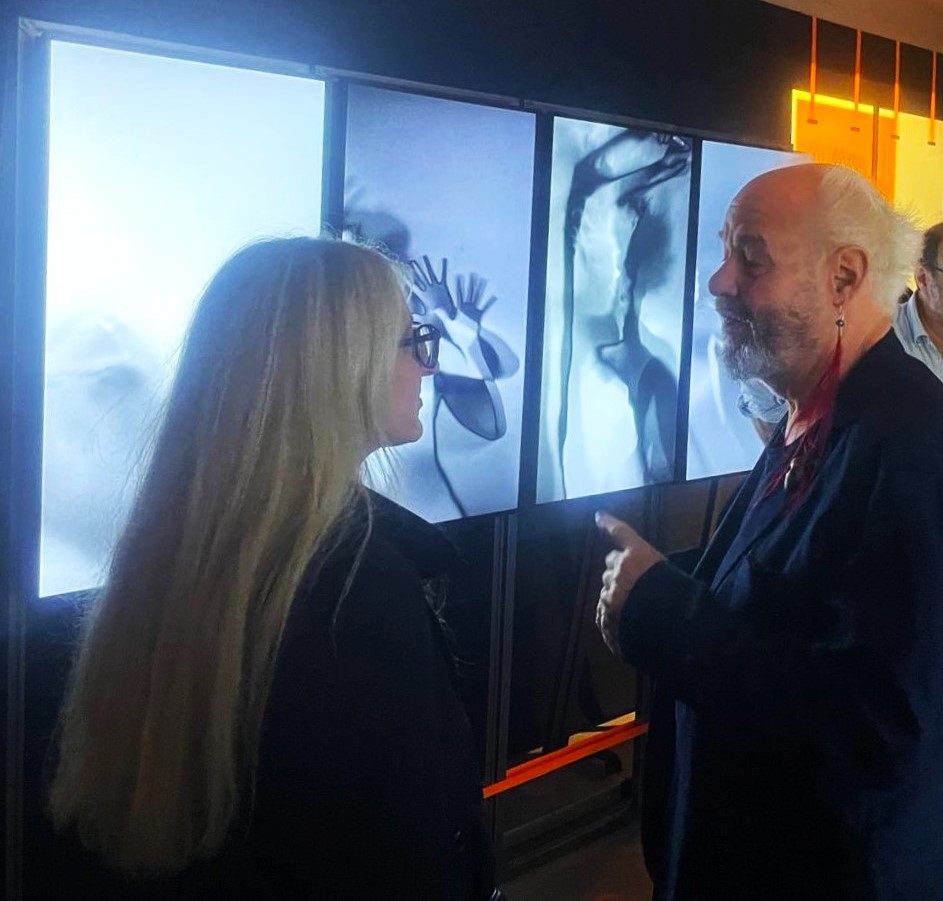
____________________________________ENGLISH TEXT
Stirring Transformation. John Sanborn’s OUT OF ORDER visions
You feel the sense of transformation in front of John Sanborn’s video art. The eclectic artist, a key member of the second wave of American video artists that includes Bill Viola, Gary Hill, Dara Birnbaum and Tony Oursler, brings his work to the halls of MEET with the exhibition Out of order, which can be visited until Sunday, Sept. 8, 2024.
After a tour that touched several cities on the peninsula, John Sanborn returned to Milan as the protagonist of an enlightening meeting of the Meet the Media Guru format. On that occasion, I had the opportunity to to converse with him at length and thus got to know better his human and artistic history.
It is marked by tireless experimentation, with his living personality always combining different expressive languages, by the interplay with technology. I understood how he considers fundamental collaborating with other artists ( and their history), in order to bring to light new existential perspectives on the present and the future. One can feel the spirit of evolving time in John Sanborn’s video art, the evolution of inner and social transformation, but, above all, his invitation to embrace this dynamism of identity, relationship and communication, including through memory and mythologies.
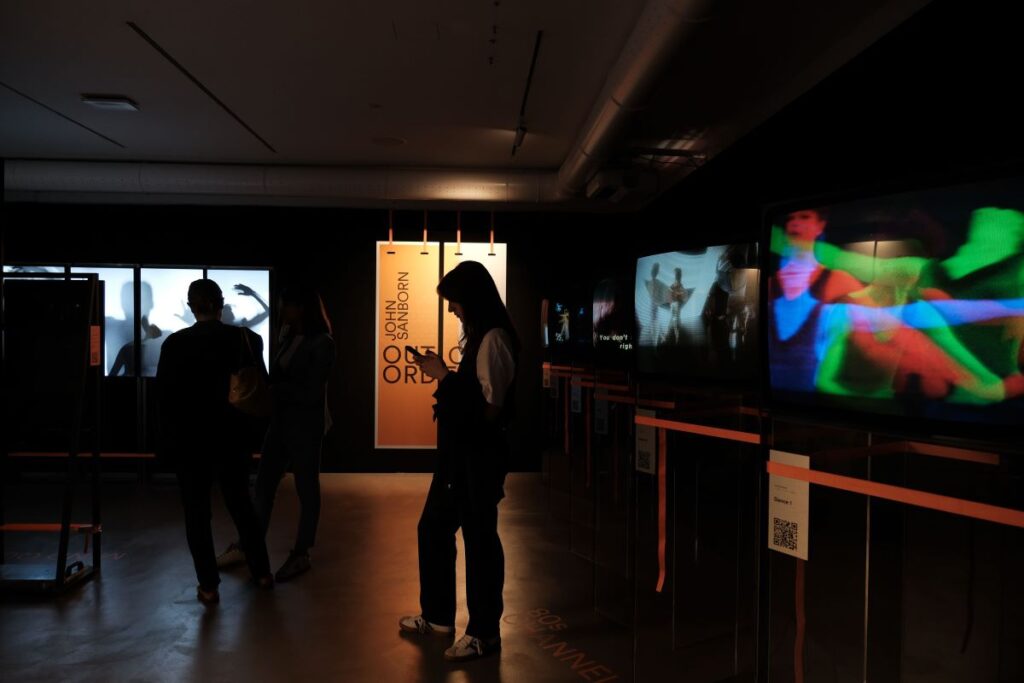
Before I delve into his world through his own words, it’s useful to give my readers key information on the exhibition, which I consider unmissable.
The itinerary of Out of Order, designed by Migliore+Servetto, is intended as a journey through time from the beginnings of the American artist’s career, starting from the video installations of the 1970s, passing through the golden age of the MTV video-music scene and interactive art to the new digital media art works, of which we can define Sanborn a pioneer. Even the choice of the title OUT OF ORDER, found in collaboration with Maria Grazia Mattei, founder and president of MEET, stirs up the feeling of transformation as a reason for art and life. Out of order, in an unexpected way, the work intends to make you change your point of view about an idea, a character, an emotion, leaving those who experience it with questions , to “look at the world just as we artists do, out of order.”
In the first gallery we explore works from the 1970s, 1980s, and 1990s. They are all in analog, visible inside cathode ray tube monitors. An interesting aspect is the set-up, which follows the logic of a collage, a unique installation that is to be read as a flow of “how my obsessions became more and more complex”. This principle activates that feeling of transformation in those who experience his art, resulting in an engaging narrative thread which connects perfectly to the historical works, just as it had done for the large retrospective Between Order and Entropy at ZKM Karlsruhe.
You recognize the works of those years as seminal. What do you think is still living of that period in your last research?
My friend Dr. Peter Weibel, who was CEO of ZKM and quite brilliant, said to me that having one foot in the past and one foot in the future is the best place to be. Time has passed, technology has changed, the world is different – but so much of what obsessed me during my early years, still inspires my passion and creativity. I want to alter time and space to represent the world as I see it. I am driven to define and transform. I like finding questions that we cannot answer and present them. And most of all I cherish the ability to investigate – who we are, how we got here, and where we are going.
In the second gallery we observe the works, Body Quartets and Mind Quartets, video installations designed to narrate a state of transformation of our self. Out of Chaos | Frisson, a collaboration with artist Lali Wilde, is an AI/AR sequence of 60 story instances explored with augmented reality using the EyeJack app.
In the context where body and mind talk about communication, what is the value, the aesthetic function of the dance within your stories?
Dance is proof of life, as the body expresses desire, courage, health, age – so many aspects of existence – in ways that exceed language and image. I use dance to say things that words fail to express, and to create shapes of humanity that I can use to close the gaps between expression and understanding. Our bodies are will, personified through a physicality that cannot be ignored or denied.
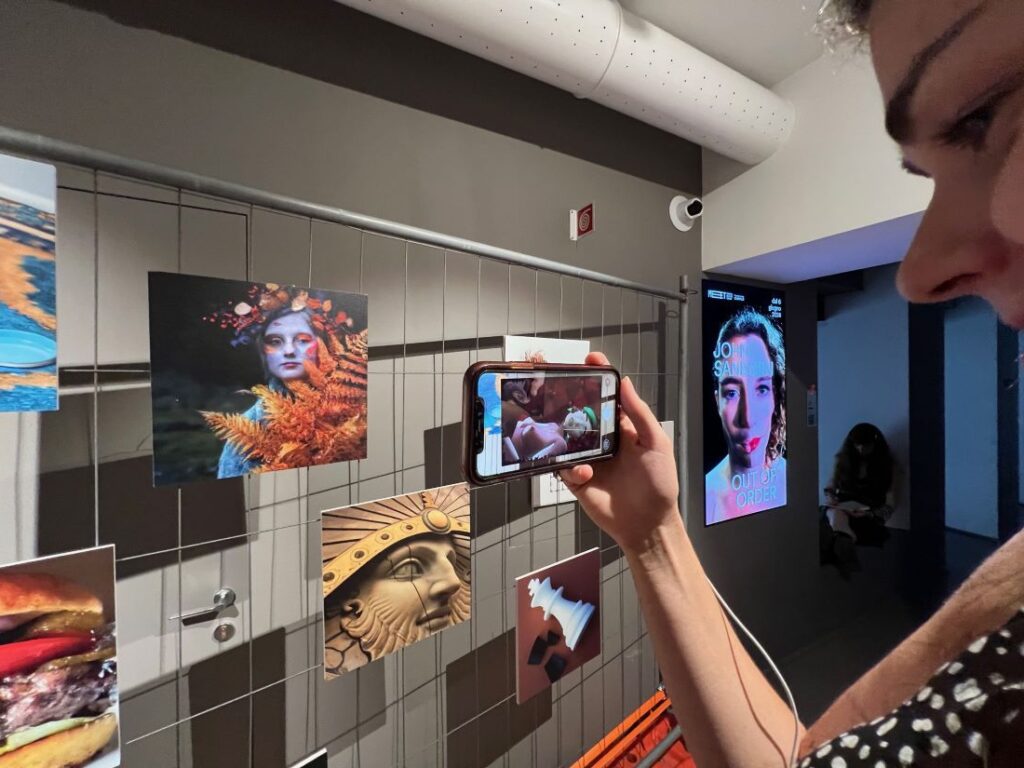
How has your relationship with technology changed in recent years?
My relationship with technology has not changed at all. I am still stimulated by tools and how they can facilitate my practice. Each new advance has allowed me to do something different or more completely, offering me more options, with which I can create. At first it was the sheer independence of recording, then the precision of frame-accurate editing, followed by layering and repositioning. A big leap was from analog to digital “desktop” video, which gave me a freedom to expand my scope and enlarge my scale of work. Recent generative tools are still developing, and it’s a pleasure to do a new dance with the machine.
The third gallery offers Mythic Status. A composition of four videos, each with a narrative of its own. portraits of the classical gods Apollo, Atalanta, Nyx and Hercules are embodied by queer and gender fluid performers, the result is a merging of their personalities with the mythological characters. Also the monumental work V+M changes perspective on an ancient story becoming pleasantly imbued with contemporary elements, developing actions from a classical theme such as desire. Now screened on the three walls of the immersive hall the 2016 9-channel installation, created by John Sanborn for the VideoFormes Festival founded and directed by Gabriel Soucheyre, acquired by Kunsthalle Prague in 2022.
Why in works like V+M and Mythic Status you mixed mythology and the paintings of the Past, with contemporary visions, like LGBTQ+?
For V+M, as I was interested in “the story of, the story of”, I thought to dissemble the story of Venus and Mars in order to better understand how we arrived at the representation of men and women that has been accepted, and repeated, for hundreds of years. Why is it that we bind both gods with gender role confinement? Does Mars have to be a man and Venus have to be a woman? And if so, why?
In various versions the love affair between V+M is tantamount to sin, and the intimacy achieved is assigned a specific cast – the different genders participate in a ritual. That misconception (actually a flaw in the storytelling) is easily dismissed when you review all the shadings of Venus as a nude supplicant, and Mars as her defiant paramour. The painted images are often reversed, so it’s easy for me to simply rewrite their story. The “evidence” allows me to convict our convictions and say proudly that we are all V+M.
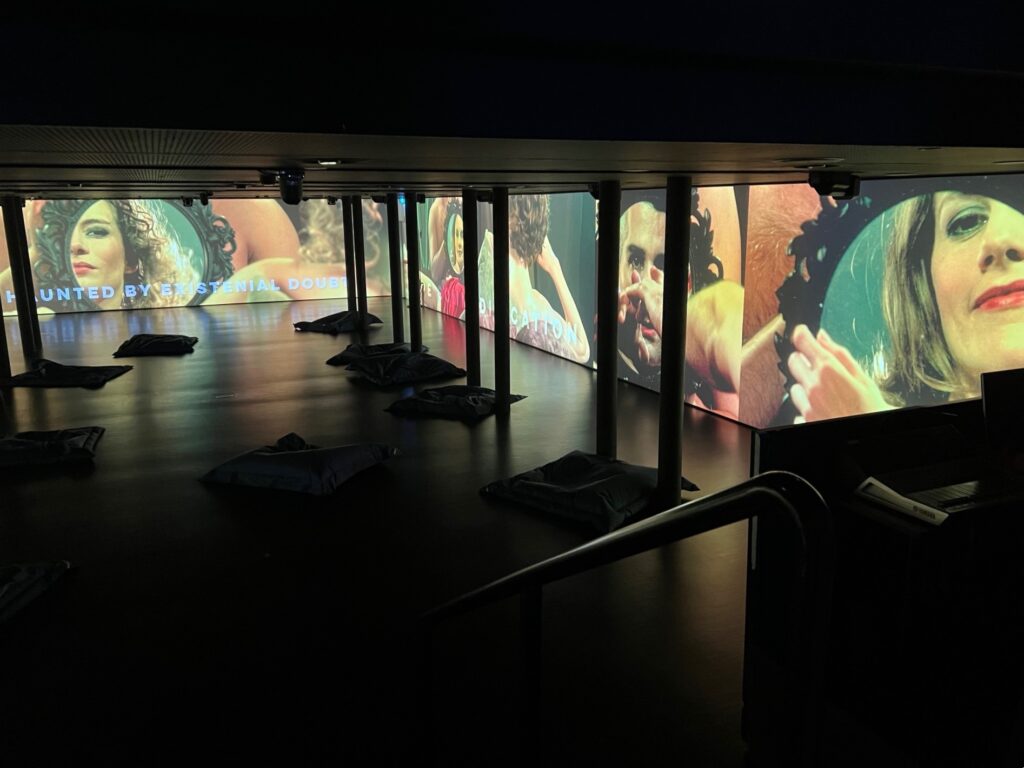
Do we need a new mythology to tell the story of the story of…?
With Mythic Status I believe that we have indeed begun to write our own mythologies of gender, as the profiles of gods verses humans has always been to create a desired “altered state” to contrast an imagined glory, with everyday human life. If courageous people move “gods” aside to create a freedom for themselves, then does it not make sense that we celebrate them, and offer their stories in place of simplistic moral tales? It seemed much better, for me, to recognize heroic individuals than to elevate fictional meta-humans and devote our time to telling and retelling them.
You’re so enthusiastic about the connection of other people in your research. Can you tell me more about two experience that you consider crucial?
Very good question. Obviously I worked with many great artists, and Nam June Paik and Robert Ashley had a huge impact on my life and work. As for specific instances of how collaboration altered my life and work, I can select so many, but here are 2.
In creating Untitled (1989), with Bill T. Jones, I intersected with communities (queer and people of color) and values that were beyond my comfort zone, so I had to listen, respond and recognize attitudes that I had never really embraced before. I was shaping a very intimate expression of grief that spoke directly, with no references, to death, AIDS and the loss of a life/work partner. These were huge themes that stretched my ability to connect with and transform movement, text and video to embrace subjects we would rather avoid. To communicate these emotionally charged topics to an audience meant that I needed to find specific points of empathy within myself so I could truly channel Bill’s anger, and grief.
When I had the idea to create Mythic Status and was introduced to Jiz Lee, I found myself totally out of my depth, and way beyond understanding of gender fluidity, but eager to listen and understand. Jiz is a gender queer porn star, author, activist and icon of transformation. I explained to them what I wanted to achieve, which must have sounded crazy, but they waked me through their story, their choices and how they remade their life so that they could be “themselves”. We spoke of pronouns, gender choices (gender is NOT sex), and the complexities of asking the world to respect choices they might not understand. All of which went into the work, as I used my own awakening as a template for what I hoped would happen with viewers.
Thinking of “bigger work, installed work we are talking about a combination of time and space, and the use of the body to actually experience the work.” Could you explain to me how it happens in remaking V+M in the immersive room at MEET?
In all versions of V+M (3 in fact) I am asking the viewer to NOT just stand there and watch the pretty pictures, and I make it impossible to do so to genuinely appreciate the work. It’s too big to scan at once, so you must move your body, swivel your head, and (metaphorically) allow the work to move you. While I do not reject passive appreciation of art, the mind wants to explore and ask questions when it sees something creative. Why not ask the body to participate in this experience as well.
I designed the structure of V+M to instigate large scale movement to tell “the story of, the story of” Venus and Mars, merging the sweep of this epic love story with choreographed images and waves of music that insist you involve your body as well as your mind. And yes, I want everyone to dance the tango.
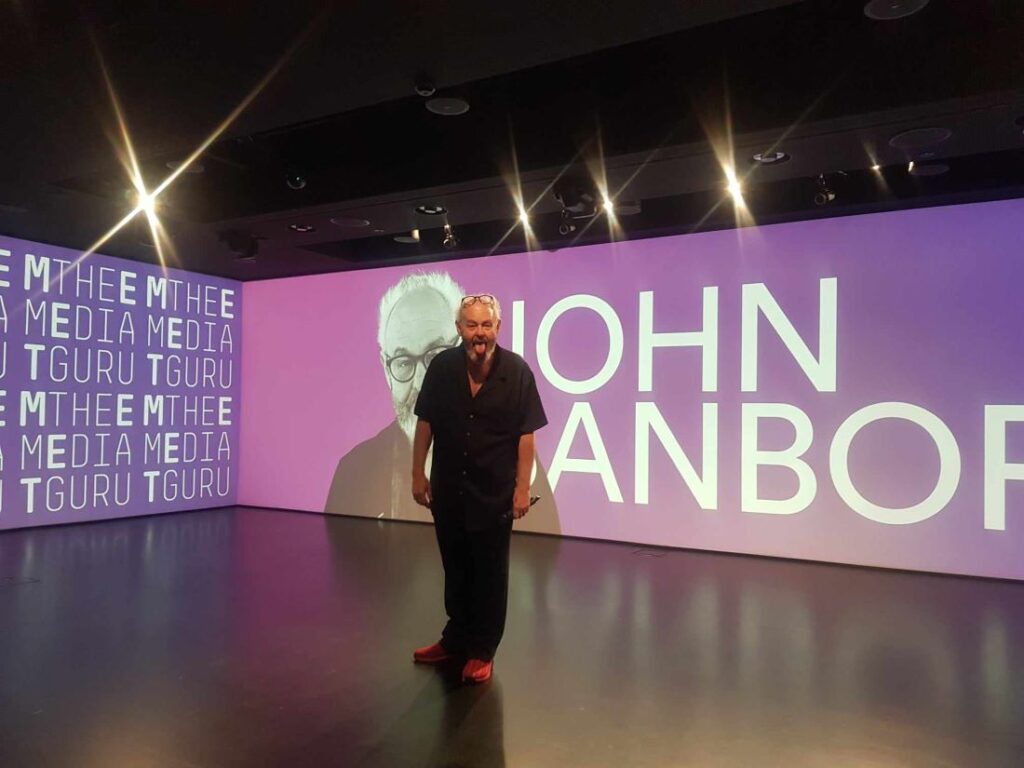
That tension on transformation, a valuable keyword for understanding all of John Saborn’s production, invites us to question perceptions and prejudices. We learned how often performers embody relevant issues through their lives and actions on stage, such as identity ( including gender and disability) social justice, inclusion. Thus we’re participating in the operation of artworks created to activate questions through scenarios which are disobedient towards a traditional storytelling.
“Not always to solve our problems, but to face our condition, understand it and ask us to do something to change, starting with ourselves”, experiencing the world OUT OF ORDER. A profound message explored during Pride month, in the Milanese district of Porta di Venezia “inhabited” by the LGBTQ+ community, where MEET, which shares the value of diversity, is based.
M.O.

